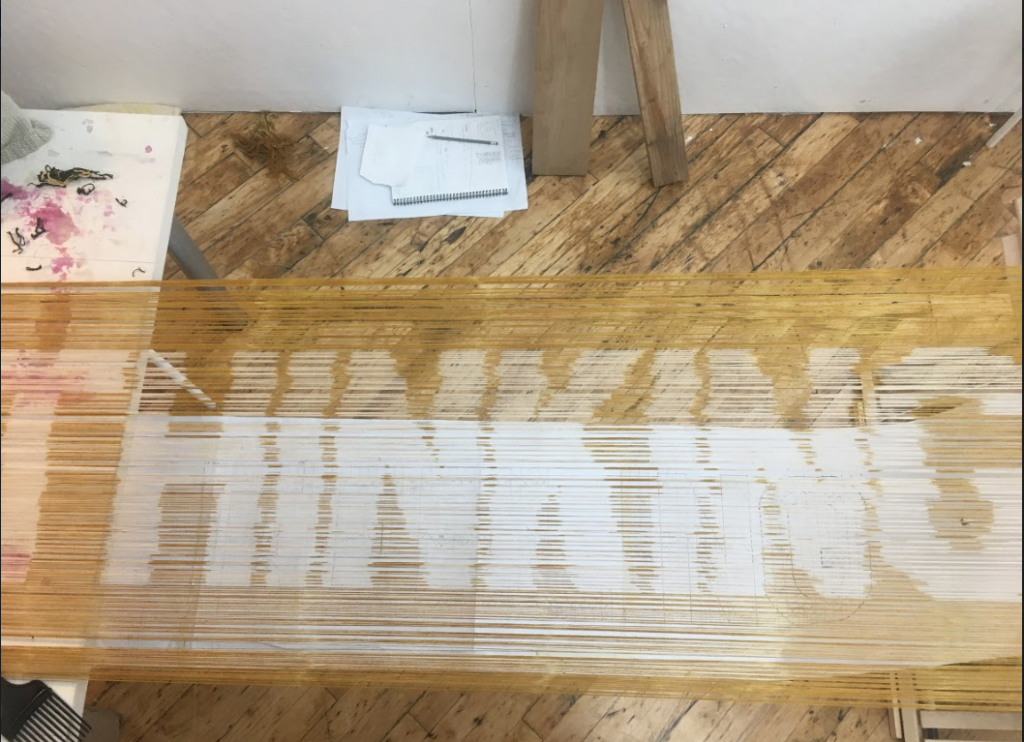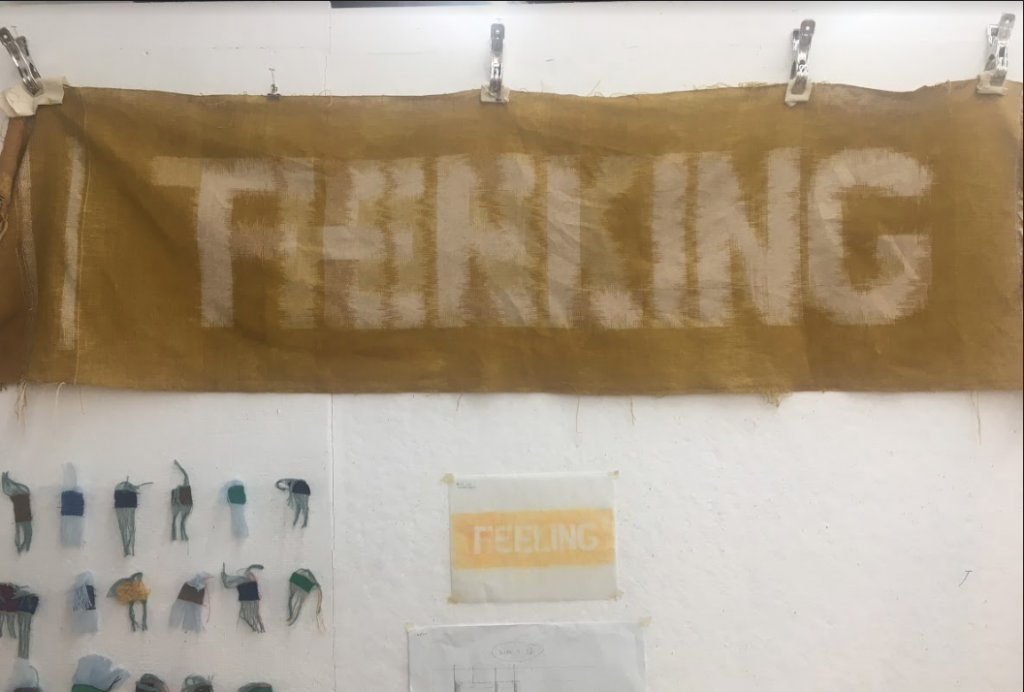AIR Artist Highlight: Jamie Boyle
Jamie Boyle is a visual artist who has frequently collaborated on the creation of material stuff for performances. Most recently, she designed the garments and props for choreographer Faye Driscoll’s Thank You for Coming: Play. Since beginning the Textile Arts Center residency, Jamie has been primarily exploring weaving and dyeing processes in an effort to create objects that contain in themselves a performative sensibility.
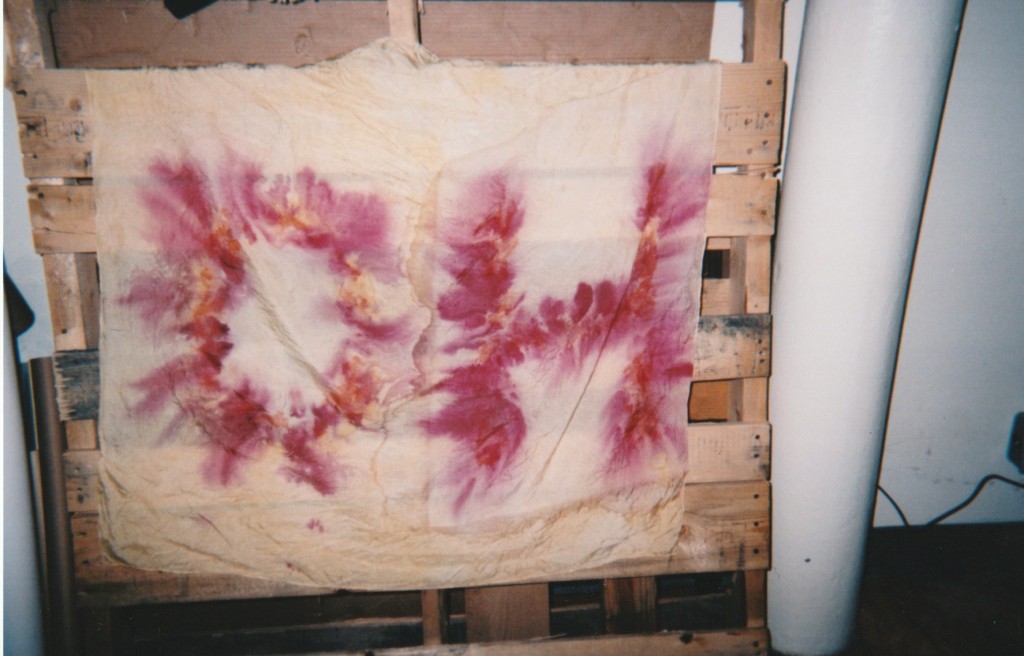
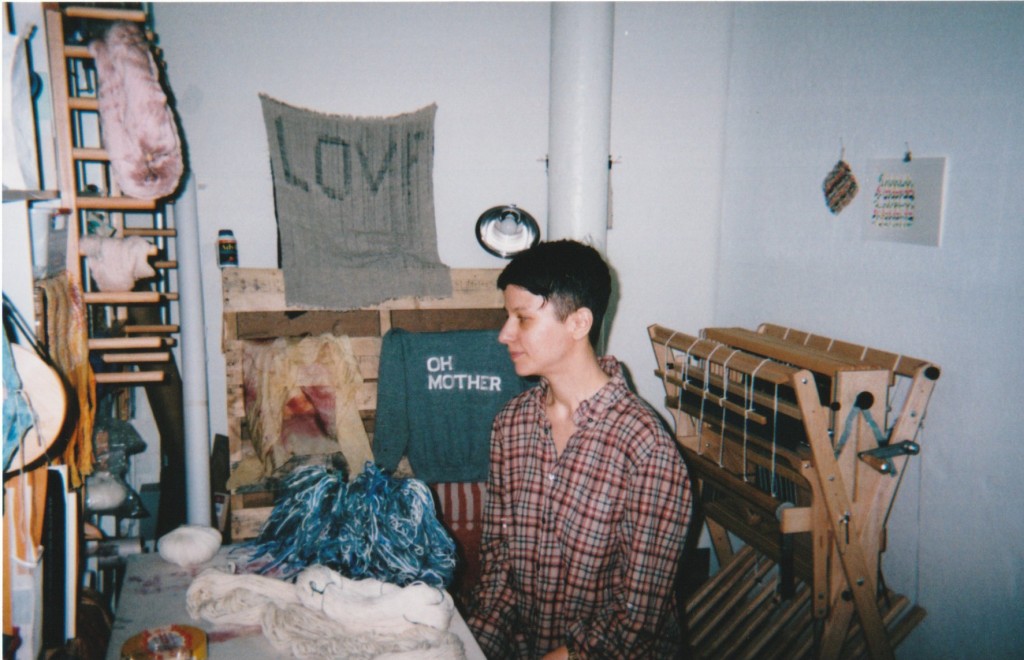
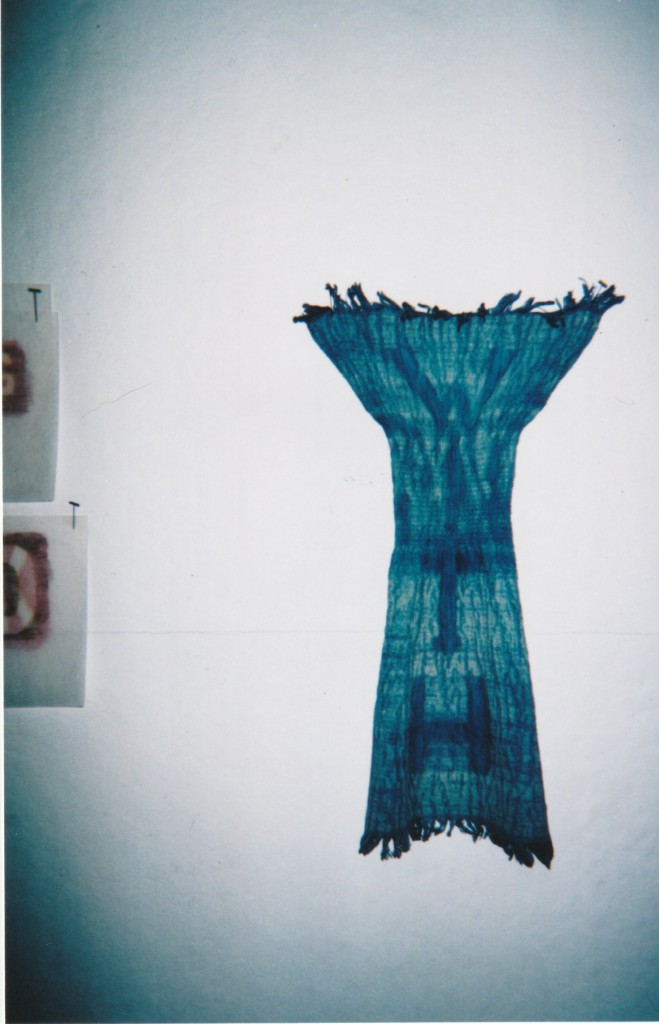
Above photos by Mariel Rolwing Montes on 35 mm film with Canon Rebel 2000
What process or technique has been most integral to your work so far?
Weaving has been primary for me since beginning the residency. In the fall, I bought a loom! It felt like getting married… I really committed! I love the process so much, even all the tedium. I think it really suits my temperament. Anyways, yes, I have been exploring different techniques and possibilities, though I know I am only cracking the surface. Lately, I’ve been experimenting with some natural dye techniques as well.
How long have you been working within these mediums?
I took a weaving class a year and a half ago. That was the first time I touched a loom, aside from a potholder loom that I was totally crazy about as a kid. In fact, one pot holder that I made during that craze is hanging on my studio wall. I love the color combination; somehow, I can’t come up with a color palette like that now, so I have that up there for inspiration. Trying to let my child self guide me a bit.
Also, after grad school, I worked in Ann Hamilton’s studio for several years; among many things, her work often draws upon the practices and language of weaving and textile processes, often expanding that language poetically to create large-scale installations. I learned so much from her; working in her studio was my first real education in textiles (and so many other aspects of art and life). But, it wasn’t until fairly recently that I finally went for it and decided it was time to actually try to learn how to weave.
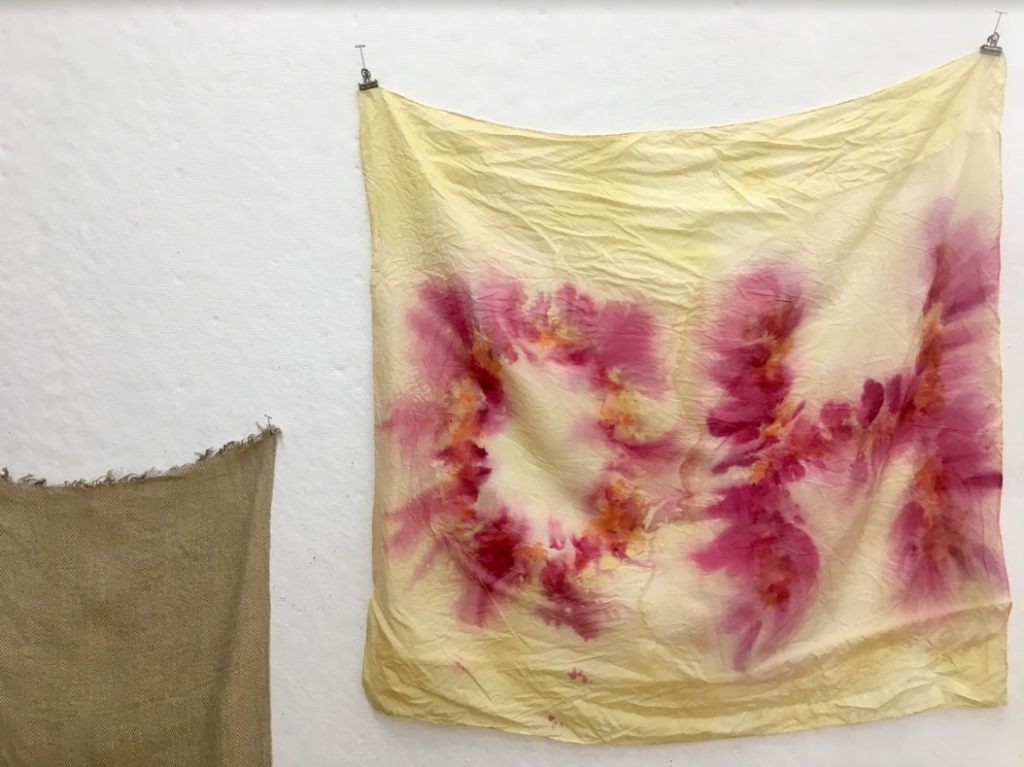
Has there been any driving force or any idea in particular that has been consistent for you throughout these different mediums and practices or the way you’ve engaged with art?
I think a lot of it comes from my relationship with performance and dance, and body and illness. I can backtrack a little bit. I was a dancer when I was younger, but in my early twenties, I became really sick, and my body changed significantly. I went from being mobile to being pretty immobile quite suddenly. So, I rerouted what I was doing, and thanks to the encouragement of my older brother and my mother, I studied visual art, thinking I could translate some of what I was doing in dance to some other form. Not that much time had elapsed from when I was in a dance studio to my time in art classes, so in my muscles I still had this memory—muscle memory—of choreography that was very real. I could feel it. But, I couldn’t perform it any longer. So there was a dissonance, an inability to communicate information, that was both frustrating and informed my very early visual art explorations. And, in many ways it still does; it was formative for sure.
I’ve thought a lot about that personal experience and about how our experiences, even our most boring or unremarkable, lodge in our bodies in a way. Even things that we disregard, like trash that we see, or logos, or pop music that we hear, become integrated in us in some way. And those experiences bubble up sometimes, sometimes in unexpected and profound ways.
How has the physical aspect of working within the medium of weaving, a very slow time based process and sedentary activity, affected your work?
I’m really interested in how weaving registers a physical state. I’ve recently heard other people say things like this too, like, “Oh you can tell when a weaver was having a bad day,” because the tension changes, or there’s some subtle change in the cloth.
It’s actually quite a physical process. Even though it seems like such subtle movement. I’ve been drawing upon my experience with dance lately to try to make a choreography of the work at the loom, thinking about what muscles really need to be firing, so that I can maintain the practice. I was getting such stiff necks and shoulder and back pain for a while there…
There’s also a kind of choreography with the treadling pattern and a choreography of using a different material, how to pull or not pull it in tension. Getting to know each material, it becomes this very embodied practice. I think there is a register of the body in the cloth. But, then I’m also absorbing the information of the weaving pattern into the body, as I’m working. So it’s also kind of going both ways—into the body and out of the body.
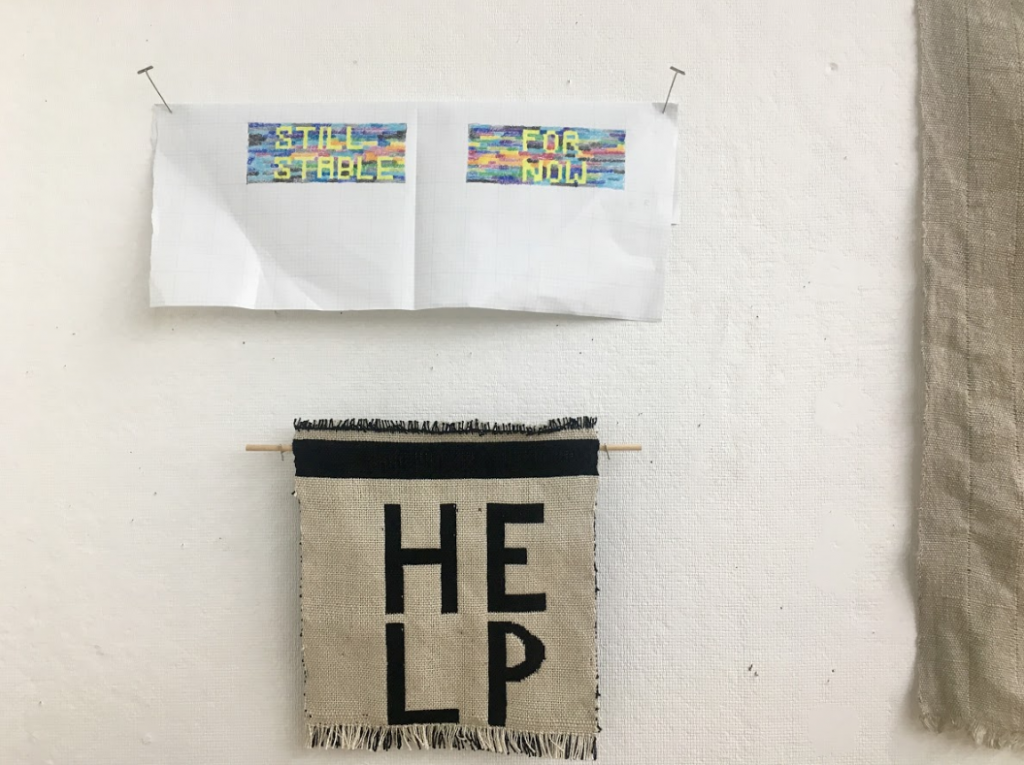
Do you have any rituals within your studio practice? Things that you like to do while you work?
I make a pot of green tea, usually first thing. I like to ease into the working day. I haven’t been listening to music or podcasts very much, unless it is an uncommonly silent day at the studio, and I’m engaged in a task that doesn’t require my full attention. If that’s the case, I will listen to an On Being or a Fresh Air interview that I’ve already listened to. I like the familiarity and the chance to hear something again in a new way.
But, it’s a very active environment here, and a lot can be learned from hearing the kids work, you know? So I don’t want to miss a chance.
Can you talk to me a little bit about this piece? What medium did you use?
It’s woven, primarily using a hand-knotting—rug-weaving—technique. I was initially drawn to the technique because it could be pixelated, like that. But, I was also interested in the degree of illegibility the other side might be able to hold simultaneously.
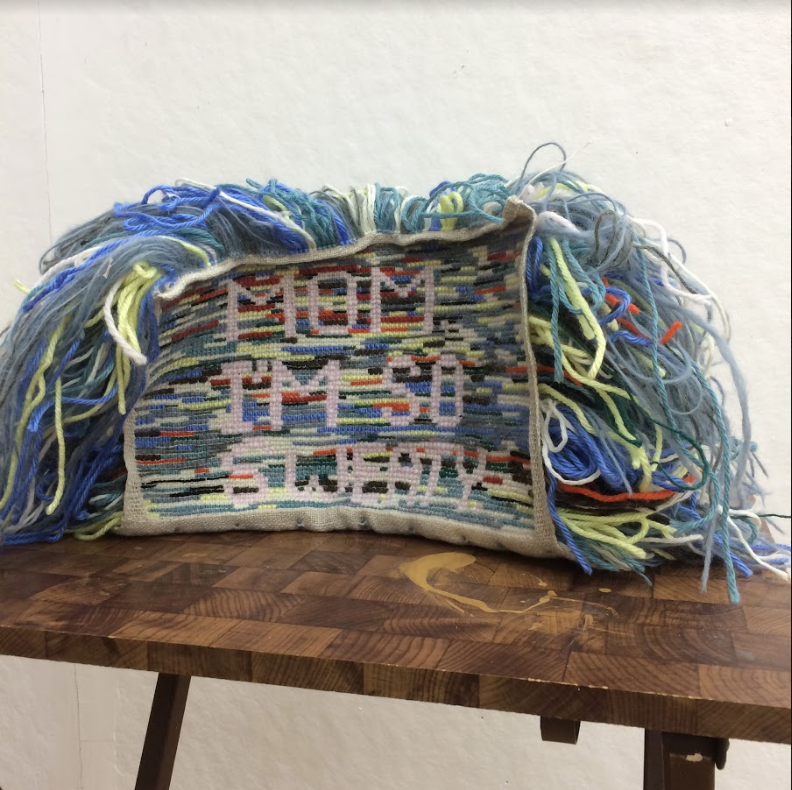
What were you thinking about while making it?
I had been reading a book that explores metaphors of weaving and cloth in Greek mythology, and I was really starting to become really troubled by the way that weaving was used as a metaphor— combing the chaos of people and weaving it into a nicely gridded society where everything was held in tension, very ordered, and had its place. In response, I wanted to make something that felt very chaotic, to make a mess, while using a weaving technique. But, then I was also using the opportunity to play with the pixelated qualities of the knots and incorporate text. So, the text as I was facing it, while making it on the loom, was illegible; it was backwards, and really messy. But…I would cheat sometimes and look at the underneath to reassure myself where I was in the pattern; the underside was neatly pixelated and legible. So, I guess I ended up with a finished piece that is only one-half messy… I am interested in pushing the idea of illegibility further. On this one, I only went half way. I was a little hesitant and conservative.
My health wasn’t so great while I was working on this piece. “Mom I’m So Sweaty,” is a sort of whining cry (that I wished I could still make!). As a child, I always wanted to be snuggled when I was sick, like a “mom, I’m so sweaty, but I need a hug” sort of situation. I was trying to conjure that type of whining and play with that.
Overall, I was thinking about illness and messiness, and thankfully, though it didn’t come until after I finished the piece, I was able to see the possibility of humor in all that.
What is the relationship to text within your work?
My mother was a calligrapher, so I grew up watching her make these beautiful letters and was surrounded by framed fragments of text, quotes, and prayers written in meticulous script. And books, she loved books. She had this little library of books that I thought were the most boring thing as a kid; books about illuminated letters and manuscripts, histories of writing, and one in particular that I remember making fun of: a book about the history of punctuation! All of these amazing books that now I want to run back to Pittsburgh and read! I guess that’s how life works, right? Things sometimes come on a delay…
In my mother’s later life she became a very skilled potter, making these perfectly smooth and super thin handbuilt pots. Then, she started inscribing the pots with her calligraphy— she was making objects talk. I feel her work in my work. I realized recently that I am carrying on something of her art practice in my own. Though, she might have some suggestions on my craft and lettering…
So you talked about dancing, are there any other interests you have outside of the studio? Passions that also find their way into your work?
I love cooking. And, I really love taking care of our (my husband, me, and our two cat companions) domestic setting. That domestic care-taking and my studio practice don’t feel all that dissimilar to me. Maybe because my studio practice was situated within my domestic setting for so long, too, that they integrated. But, there’s a certain kind of care that I feel in both, a tending to things.
Yeah, that’s really nice. That is how it feels to look at these pieces, too. The sense of care going into them. How would you like people to experience your work? Do you have a vision for it?
A gallery setting, or anywhere that you can be close to it, maybe in some instances, touch it, if it seems right. I’m still puzzling over how to create context for it, for the work. There’s always this straddle for me between is this a performance, is this a writing, is this just an object…can those practices come together? Some objects could be part of, or for, a performance, maybe like a show and tell. I love stories so I’m interested in the performative possibilities, but I’m also really interested in trying to create objects that are what they are and are not activated by anything else, thinking of them more like artifacts.
Is there anything else you’d like people to know about your work or your practice?
I feel like I’m just a picker, and I try to listen all the time.
I heard an interview a long time ago now, with Tom Petty, and he said something to the effect of he didn’t feel like he ever wrote a song, that it was more like he caught them (like something in the air) and that he then had a responsibility to them. I relate to that feeling, like making art is more about finding or asking or “catching” …
I don’t know if that’s important to know, and I guess I kind of dodged the question by talking about Tom Petty! But, I love the sense of generosity and interconnectedness that is implied in that notion of “catching” ideas…
